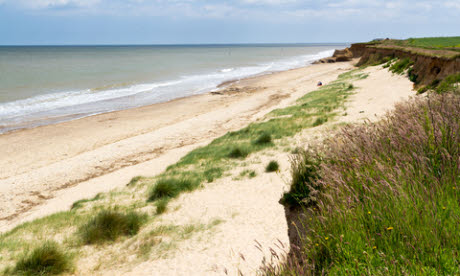
Travel back one million years through time and uncover some of Britain’s most fascinating archaeological sites...
Pronounced 'haze-borough', this sleepy seaside parish was already known for its early archaeological finds, but it hit the headlines in 2010, when some of the oldest evidence of humans in Britain was found. A team of scientists unearthed flint tools dating back almost 950,000 years ago that were probably left by an early species of human, Homo antecessor. Coastal erosion taking place along the Norfolk seafront has exposed many Stone Age sites and other finds from the area include flint hand-axes and butchered animal bones.
Dig deeper: Walk to the end of Beach Road for the best view of the coastal cliffs and keep your eye out for on-going digs. Happisburgh is still actively researched by teams from the British Museum and Natural History Museum.
Boxgrove is one of the few places where fossil evidence of really early Britons has been uncovered. A leg bone and two teeth found here are 500,000 years old and are the oldest human fossils ever found in Britain. They belonged to an extinct species of ancient human called Homo heidelbergensis. There is evidence which shows that the leg bone was chewed by a large carnivore, perhaps a lion or wolf. Also found at Boxgrove was ancient evidence of butchery by our hunter-gatherer relatives, hand-axes, and cut marks on horse, deer and rhino bones, giving rise to their nickname the Boxgrove Butchers.
Dig deeper: Boxgrove Quarry, where the excavations took place, is now owned by English Heritage, who continue to work with archaeologists to preserve and study this important site.
At 400,000 years old, the human fossils found in a gravel pit at Swanscombe are some of the oldest remains of humans in Britain. Despite our rich ancient history, human fossils are rare in Britain, so finds from this site adds to a handful of remains that have been unearthed. The skull found at Swanscombe is one of these rare finds, and belonged to a woman who may have been one of the earliest Neanderthals.
Dig deeper: Swanscombe Heritage Park has not only been designated as a National Nature Reserve but also a Site of Special Scientific Interest as a result of the important fossil and archaeological finds.
Meaning 'new bridge', finds from Pontnewydd gives us a glimpse into the lives of Neanderthals, one of our closest human relatives. These 230,000 years old remains are the oldest humans ever found in Wales and some of the only Neanderthal remains ever found in Britain. Although we did not descend from Neanderthals, their remains, including teeth belonging to an eight-year-old child, tools and animal bones helps us better understand how similar we were to our ancient relatives.
Dig deeper: access to Pontnewydd Cave, where the remains were found, is limited as the cave is located on private land. Instead, visit the National Museum of Wales in Cardiff, where you will be able to see the tools and remains first-hand.
Studies on a piece of jawbone from Kent’s Cavern have provided the earliest evidence that modern humans, Homo sapiens (i.e. us), were living in north-western Europe. At about 40,000 years old, this is the oldest known relic of modern humans in Britain, and also confirms that there was probably an overlap with the Neanderthals, which meant that we could have lived alongside them.
Dig deeper: a popular visitor attraction, Kent’s Cavern is open to the public and even won an award in 2000 for Show Cave of the Year.
Gruesome finds abound in Gough's Cave. Analysis of human bones found there revealed that the cave residents were not only some of the first humans to return to Britain from mainland Europe at the end of the last ice age but that their diet included human flesh. The 15,000 year old human bones show cut marks that indicate flesh being scraped away using stone tools, and analysis of human skulls shows that they were deliberately fashioned into ritual drinking cups or bowls.
Dig deeper: the first 800 metres of Gough's Cave are open to the public as a show cave. Beyond this are caverns that are only accessible by cave diving through underwater passages.
Lions, hippos and giant deer, Central London was a very different scene 125,000 years ago. With the climate more akin to the Mediterranean, Britain in between ice ages played host to a range of exotic animals and plants. Remains of rhinos and straight-tusked elephants from warm periods, and woolly mammoths and reindeer from the cold stages have been found right across the capital, from Brentford to Ilford.
Dig deeper: many of these animal finds, along with all the tools and human remains listed above will be on display together for the first time at the Natural History Museum's new exhibition Britain: One Million Years of the Human Story, opening on 13 February 2014. Wanderlust has a pair of tickets to the exhibition to give-away online. Find out more here.